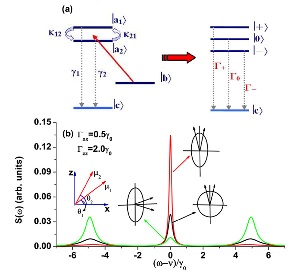Apr 23 2014
The mechanism of using the anisotropic Purcell factor to control the spontaneous emission linewidths in a four-level atom is theoretically demonstrated; if the polarization angle bisector of the two dipole moments lies along the axis of large/small Purcell factor, destructive/constructive interference narrows/widens the fluorescence center spectral lines.
Large anisotropy of the Purcell factor, confined in the subwavelength optical mode volume, leads to rapid spectral line narrowing of atom approaching a metallic nanowire, nanoscale line width pulsing following periodically varying decay rates near a periodic metallic nanostructure, and dramatic modification on the spontaneous emission spectrum near a custom-designed resonant plasmon nanostructure. The combined system opens a good perspective for applications in ultracompact active quantum devices.

In a collaboration with Peking University, we studied the utilization of the anisotropic Purcell factor to control the spontaneous emission linewidths of a four-level atom. This original approach provides a very good description of the interaction between molecules and plasmonic nanostructures in the weak coupling regime. If the polarization angle bisector of the two dipole moments lies along the axis of large/small Purcell factor, destructive/constructive interference narrows/widens the fluorescence center spectral lines. Large anisotropy of the Purcell factor, confined in the subwavelength optical mode volume, leads to rapid spectral line narrowing of atom approaching a metallic nanowire, nanoscale line width pulsing following periodically varying decay rates near a periodic metallic nanostructure, and dramatic modification on the spontaneous emission spectrum near a custom-designed resonant plasmon nanostructure. The combined system opens exciting perspectives for applications in ultracompact active quantum devices.
(a) The schematics of a four-level atomic system and its dressed states. (b) Narrowing (red curve) and broadening (green curve) of the spectral lines associated with spontaneous emission via anisotropic decay rates, compared with lines (black curve) for a vacuum. Two dipole moments lie at an angle of 0.2π. Rabi frequencies are Ω1 = Ω2 = 3.5γ0.
Further information is available in the corresponding publication:
Surface-plasmon-induced modification on the spontaneous emission spectrum via subwavelength-confined anisotropic purcell factor
Y. Gu, L. Wang, P. Ren, J. Zhang, T. Zhang, O.J.F. Martin, and Qihuang Gong
Nano Letters vol. 12, p. 2488–2493 (2012)
PDF, External link:.doi: 10.1021/nl300655n
Source: Nanophotonique et métrologie